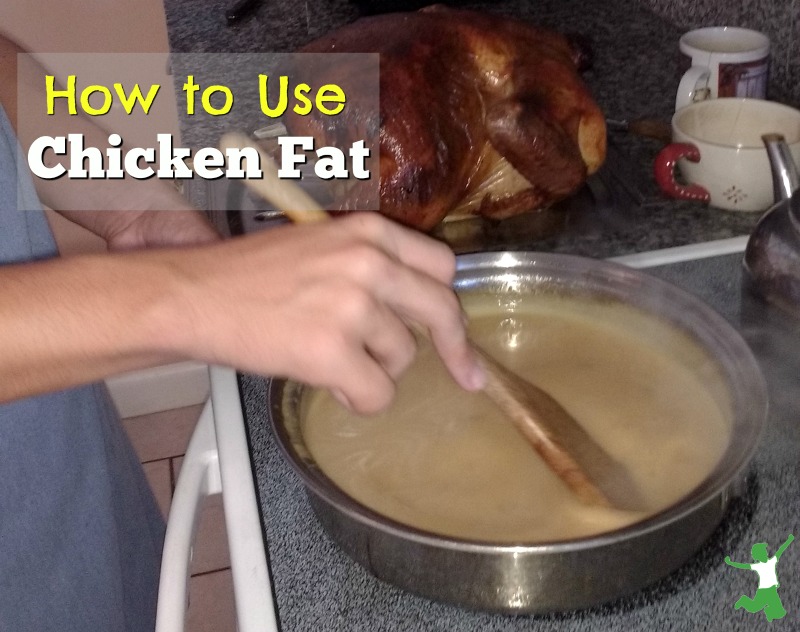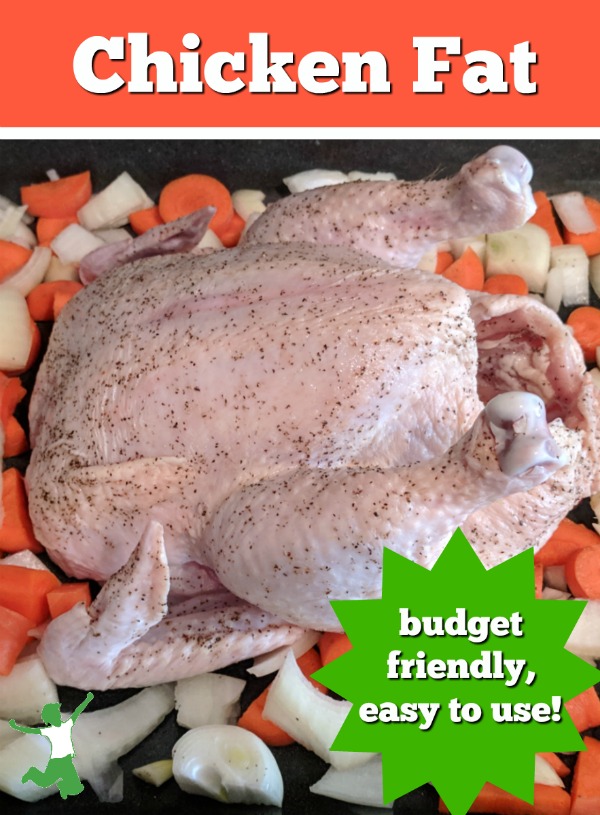Chicken fat or schmaltz is a traditional fat, very budget-friendly and quite healthy to use. Be sure to follow these important cautions if you choose to cook with it on a regular basis.
A recurring theme on this site is the critical importance of utilizing Traditional Fats for cooking. Avoiding industrialized factory fats that are rancid from processing and devoid of nutrients is critical to long term health. These frankenfats include margarine, spreads and vegetable oils. Is chicken fat, also called schmaltz, one of these fats?
Let’s take a look in-depth.
Is Chicken Fat Healthy?
The type of fats you choose for cooking can literally make or break your health!
This is the case regardless of other kitchen practices that may be right on target such as sourcing local and organic produce, consumption of antibiotic/steroid-free grass-fed meat, and use of freshly ground flour to prepare traditionally made baked goods.
Factory fats such as hydrogenated/partially hydrogenated oils (trans fats) are obviously unhealthy. Less obviously damaging are the heavily marketed liquid edible oils. These include soy, rice bran, corn, grapeseed, safflower, sunflower, canola, pumpkin seed oil, and others as they are modern fats only recently introduced to the human diet.
Consumption of these industrialized fats can cause cancer, heart disease, immune system dysfunction, fertility problems, learning disabilities, growth problems, and osteoporosis. They are inflammation in a bottle! They must be vigilantly avoided to achieve maximum health and vitality. (1)
Nutrient-rich traditional fats best used for cooking include the following:
- Butter
- Ghee
- Lard from pigs outside in the sunlight (this recipe plus video shows you how to render lard at home)
- Tallow and suet from beef and lamb
- Chicken and goose fat (schmaltz), and duck fat
- Coconut, palm kernel, red palm oil, and palm oil
These traditional fats are primarily composed of saturated and monounsaturated fats. They maintain their integrity when heated, meaning they do not become denatured forming free radicals during the cooking process. This is true as long as the heat remains below the smoke point. These fats have nourished healthy cultures for millennia.
Wondering why olive oil is not on this list? This article outlines the reasons I choose not to cook with olive oil although it is great for salad dressing and is definitely a healthy traditional fat.
Chicken Fat vs Other Nourishing Fats
What many folks do not realize is that all fats are actually a combination of saturated, monounsaturated, and polyunsaturated fats.
Polyunsaturated vegetable oils are the rancid ones full of free radicals that are used in processed foods. They are the bad fats that when consumed to excess as is the case in the Western diet, inflammation and degenerative disease is the result. Vegetable oils also contribute to a tendency to gain weight.
A common characteristic of nearly all traditional fats is that they are all very low in polyunsaturated fats. The one exception is chicken fat which is about 21% polyunsaturated (2).
This compares with a polyunsaturated fat content of the following nourishing fats. (2)
- 4% for butter and ghee
- 4% for beef tallow
- 8% for mutton tallow
- 11% for goose fat
- 12% for duck fat
- 3% for coconut oil
- 9% for palm oil
- 2.3% for palm kernel oil
Cautions using Schmaltz
If you are new to Traditional Diet and your pantry is still fairly loaded up with processed foods in the form of chips, crackers, cookies, etc – even if organic – it is best to use another traditional fat for cooking than chicken fat.
This is because eating even a moderate amount of processed foods will likely result in an excessive intake of polyunsaturates. Cooking with chicken fat will exacerbate the problem as it is the highest in polyunsaturates of all the traditional fats with the exception of sesame oil. A much better choice would be to cook with one or more of the traditional fats listed above that are very low in polyunsaturates.
On the other hand, if you have eliminated most processed foods from your diet and are eating nearly all whole, home-prepared snacks and meals at home, then cooking with schmaltz poses no problem whatsoever.
The reason? There isn’t an excessive amount of polyunsaturated fats in your diet already.
Healthful and Budget Friendly
I hope this article has not put anyone off chicken fat! That was certainly not the intention.
This wonderful traditional fat is fabulous to include in the diet. However, the caveat is the high polyunsaturated content that is not common knowledge for many people.
Instead, I hope this information motivates you to further reduce your family’s use of any remaining processed foods.
Then, you can fully enjoy and utilize the budget-friendly convenience of chicken fat with complete peace of mind.
It is so simple to gather rendered schmaltz into a jar. Simply peel it off the top of a quart of chilled homemade chicken stock! Then, use it for vegetable sautes, stir fry and other savory dishes. It keeps for weeks when refrigerated.

How to Use for Maximum Health Benefits
Think you’re ready to use chicken fat? A good rule of thumb to know for sure is to open your pantry and take a look. If you see a lot of boxes from the store, you should be doing your cooking with a traditional fat.
These fats include butter, ghee, coconut oil, tallow, lard, and suet. Palm, goose and duck fat, while a bit higher in polyunsaturates, would also be fine for cooking occasionally even if some processed foods still remain in your family’s diet.
Save the chicken fat for when you are more fully transitioned to Traditional Diet. This approach ensures that no overconsumption of polyunsaturates occurs which would keep the brakes on your journey to optimal health.
Once you get to that point, there is quite possibly no cooking fat that is easier on the budget than schmaltz!
References
(1) Principles of Healthy Diets
(2) Chicken Fat Nutrition Data
(3) Schmaltz
More Information
Selecting a Healthy Cooking Fat and Reusing it Safely
Argan Oil Benefits Health
Walnut Oil: Healthy Sub for Flax Oil








There’s a link in the post to my thoughts on olive oil. Good traditional oil but I don’t use for cooking for specific reasons.
Lard is listed … under 10% poly so good.
Thanks, Sarah, for that very important point
about grapeseed oil I had no idea it was so
high in polyunsaturates. I guess I’ll go back
to drizzling olive oil on my salads, and maybe
make my own mayonaise…
And what about the duck and goose fat? We eat regularly foe gras in goose fat:))
Where do olives fit into the scheme? They’re mostly monounsaturated.
Chicken fat is alright but I sure do love pastured pork lard! I think I will stick with that….I just eat the chicken fat when I roast a whole chicken. Plus there are no boxes in my cupboard. 🙂
I am new to traditional cooking. I have been reading your blog with great interest. I am just wondering though if traditional cultures used healthy fats and processed their grains and didn’t get cancer and diabetes etc., what did they die of? In theory shouldn’t they have lives really long. I am NOT a troll. I just have questions.
James, I’m glad you asked that question. I would also like to hear Sarah’s take on this as it seems to be one of the main counter points that critics of a traditional foods diet make: they point out that we have longer live-spans now. The first thought that comes to my mind for causes of death in traditional cultures is sickness/viruses (even a very strong immune system is not impenitrable. When isolated cultures came in contact with a new popution, the native americans and the europeans for example, the native american’s immune systems simply hadn’t had the opportunity to arm themselves against european illnesses), infections, accident, starvation/famine. I would love to know if there is any data that lists the major causes of death 100 years ago vs today (I’m not sure how much data would be available going back further) and the likelyhood of dying from those causes. I’d also submit that while we are staying alive longer today are we really living? Two of my grandparents spent many years in a nursing home before they passed, and I wouldn’t call what they did “living”. When my time comes I’d rather kick it at, say, 80 still active and taking care of myself than live to be 85 but spend those last 5 years in a nursing home dying slowing 🙂
Good question, Jason. A lot of paleo bloggers have looked into anthropological studies on traditional cultures to see what those people died of. They did not die of disease but from old age, encounters with wild animals, or accidents. Look into Ryan Koch’s blog “Health matters to me” or Melissa McEwan’s blog “Hunt gather love”.
Traditional cultures died of … of course accidents and other uncontrollable acts of God or ….. (drumroll please) OLD AGE! What a concept. Dying in your sleep or just dropping dead one day because it is your time to go.
No wearing a diaper and being in a wheelchair for 10 years gradually slipping away in pain and agony over a long period of time because your body is ravaged by nutritional deficiencies but your’re kept alive by drugs, surgery and other magic of modern medicine like what happens to people today.
The other fact that is often left out of the “people only lived to be 35 in traditional cultures” argument is that life expectancy statistics include infant mortality. In most cultures, if you survived the first 5 years (infections, accidents, famine) you’d live to a ripe old age.
Lindsay
I was going to bring up this point, too. The only reason why it appears that we live longer now, is that we do not die as infants in nearly the same numbers as we once did. We need to be reminded of how averages work!
Awesome, thanks for the explanation. I regularly cook brown rice and oven baked potatoes with chicken fat. I hardly keep processed foods in my pantry, so it looks like I’m good to go!
My family transitioned to a paleo/primal approach about 11 months ago. We love cooking with virgin organic coconut oil, ghee, and tallow which I ‘harvest’ from batches of beef bone broth. I prefer not to use chicken fat because of the fatty acid makeup even though we have banished packaged goods! Use lard occasionally…source locally from pastured animals.
There is data showing a better omega fat ratio for pastured animal products.
Chicken skin is wonderful to cook with, in the folicles of the chicken has immune booster properties… Stewed/croc pot whole chicken is the best for ailments..Remember to chill the broth to remove the solidfied fat that rose to the top..